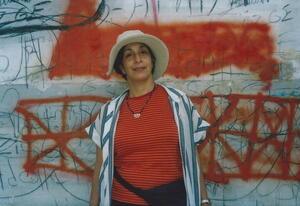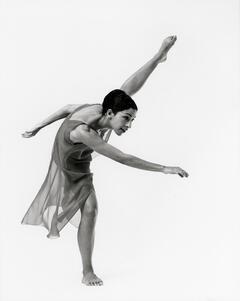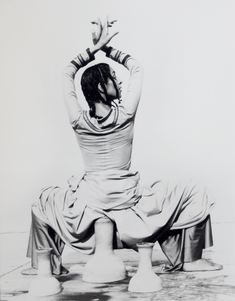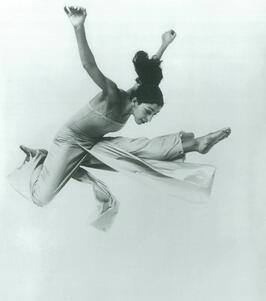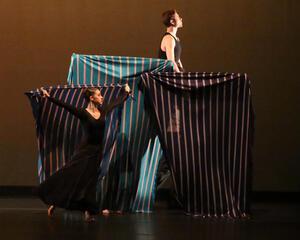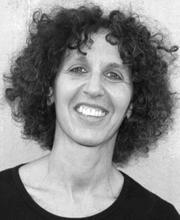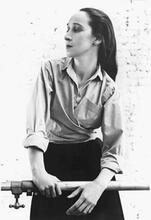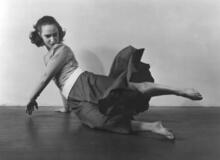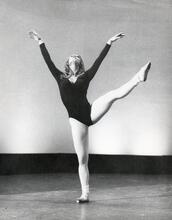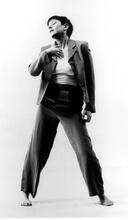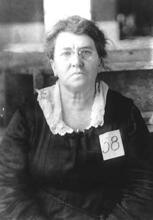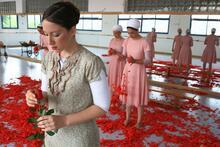Ze'eva Cohen
Yemenite-Israeli-American dancer and choreographer Ze’eva Cohen was a postmodern dance leader in New York between the 1960s and 1990s, a founding member of Dance Theater Workshop, and founding director of the dance program at Princeton University. She choreographed dances for companies all over the world, was a dynamic and dramatic solo performer, published articles on her work and history in English and Hebrew, and influenced generations of dance students. This entry details her dance training in Israel and New York, her performance in Anna Sokolow’s companies, her choreography at Dance Theater Workshop and in her solo repertory concert, her choreography with Ze’eva Cohen and Dancers and in her concert Female Mythologies, and her work in dance education at Princeton and with the International Baccalaureate Organization.
Ze’eva Cohen is a Yemenite-Israeli-American dancer and choreographer whose work over half a century in Israel and the United States redefined what it means to be a Jewish performer. She was a leader in the world of postmodern dance in New York between the 1960s and 1990s, a founding member of Dance Theater Workshop, and founding director of the dance program at Princeton University. She choreographed approximately 50 works for companies all over the world, performed in the work of many contemporary choreographers, published articles on her work and history in English and Hebrew, and influenced generations of dance students.
Family History
Cohen was born in Tel Aviv on August 15, 1940. Her parents, Bat-zion Mashat (born in 1914 in Tel Aviv) and Nissim Cohen (born in 1908 in Egypt and immigrated to Tel Aviv in 1912), were members of the Irgun movement to fight British rule in Palestine. Her father was arrested as a political prisoner for his activity with the Irgun and spent five years in a Kenyan prison. Her mother was a nurse. She has one brother, Eytan Cohen, twelve years her junior.
The Cohens were the only Yemenite family in the Ashkenazi neighborhood in North Tel Aviv where Cohen grew up. Cohen’s maternal grandparents and paternal grandmother, who were born in Yemen and spoke mostly Arabic, lived in the Neve Tzedek neighborhood in southern Tel Aviv. (Cohen’s paternal grandfather never arrived in Palestine from Egypt.) Throughout her upbringing, Cohen became aware of the cultural distinctions and social inequalities between Yemenite Jewish and Ashkenazi Jewish culture, not only in her Ashkenazi neighborhood but also as the second generation to grow up under Israeli statehood, singing patriotic songs and participating in the Scouts Youth Movement. Cohen’s earliest dance memories are improvising at home with her mother to music by composers including Brahms, Chopin, and Tchaikovsky.
Dance Training in Israel and the United States
At the age of five, Cohen began training in dance technique and improvisation with Gertrude Kraus, one of Israel’s leading contemporary choreographers and a prominent practitioner of German Expressionist dance. At age sixteen Cohen continued her training with Rena Gluck, an American dancer with the Martha Graham Dance Company who had made Lit. "ascent." A "calling up" to the Torah during its reading in the synagogue.aliyah aliyah. Cohen also studied the Luigi style of jazz dance with Ruth Harris, a German émigré by way of Paris and New York. At twenty, Cohen performed in two night club duet acts in Tzfat (Safed) in northern Israel near the Lebanese border, where she danced with Israel’s first jazz ensemble. Cohen completed her army service between 1958 and 1960, during which time she performed with the choreographic collective Bimat Machol (Stage for Dance), touring to many Israeli cities and kibbutzim. Cohen then danced in Anna Sokolow’s Lyric Theatre from 1962 to 1963.
Cohen left Israel in 1963 upon Sokolow’s invitation and immigrated to New York to pursue a dance diploma at The Juilliard School, which she completed in 1966. At Juilliard, Cohen trained in modern dance with Martha Graham Company members and with José Limón, and in ballet with Alfredo Corvino. Cohen’s first professional-level dance suite, made under Sokolow’s tutelage, was called Three Landscapes: the first, describing the hills and mountains of Israel through Yemenite-influenced upward torso undulations; the second, embodying the arid quality of the desert; and the third, portraying movements and emotions about the flow of water. Cohen’s further education included a BA in Theatre Arts from Fordham University in 1974 and an MFA in Dance from New York University in 1981.
Performance and Forays into Choreography in New York
Cohen was a member of the Anna Sokolow Dance Company in New York through the 1960s, at a time when the company finally found a lasting identity after Sokolow had spent the better part of two decades abroad. Cohen’s best-known roles are from Sokolow’s Holocaust nightmare work Dreams (1961), wherein Cohen performed the lead role of the woman in white, and two solos from Rooms (1954): “Escape,” wherein Cohen portrayed the multi-faceted fantasy of a woman in a tenement apartment imagining herself being loved by many lovers, and “The End,” wherein she embodied a young woman driven to the end of her wits. Cohen also performed lyrical roles for Sokolow, including a solo in Ballade (1964) that Sokolow made for her. Cohen additionally danced in the Pearl Lang Dance Company in 1967, where she performed the role of Yael opposite Lang performing the role of Deborah in Lang’s Song of Deborah (1949).
In 1969, Sokolow company member Jeff Duncan founded Dance Theater Workshop (DTW), a choreographers’ collective and dance laboratory in Manhattan’s Chelsea neighborhood. Cohen, along with many of the dancers in Sokolow’s company, was a founding member of DTW. Cohen performed many of her works at the DTW space, where she first developed her choreographic voice. Her work ranged from tongue-in-cheek commentary on contemporary American society, to abstract explorations, to pieces highlighting women and their histories. Cohen caught the attention of Ms. magazine with Seed (1974), a trio celebrating pregnant women and their bodies, which Cohen created when she was pregnant with her daughter Keren.
Solo Repertory Concert, 1971–1983
One of Cohen’s biggest influences on the American dance scene was through her solo repertory concert that she toured from 1971 to 1983 (from 1972 to 1979, part of the National Endowment for the Arts Coordinated National Touring Dance Program). Cohen commissioned 23 choreographers to stage an existing solo or make a new work for her (28 solos in all). The solos included Rudy Perez’s existing repertory Countdown (1967) and James Waring’s 32 Variations in C Minor (1976), which Waring made new for her. Cohen became known as one of the most compelling and dramatic solo performers, with a sharp wit who could slip into and out of any choreographer’s oeuvre, at downtown experimental and uptown established theaters in New York and in regional and national venues. One of the hallmark dances from this collection is former Inbal Dance Theater principal dancer Margalit Oved’s Mothers of Israel (1974), a four-part solo featuring portraits of the biblical matriarchs Sarah, Rebecca, Leah, and Rachel built with Judeo-Arabic and American aesthetic conventions. Cohen commissioned Oved to make this dance for her so that she could embody what she calls the movement of her grandparents. The dance’s Yemenite point of view is distinctive for two reasons: 1) Oved’s wide range of octaves singing in Judeo-Arabic and Hebrew with vocal ululations brought Arabic Jewish aesthetics into contemporary dance; and 2) in an Ashkenazi-dominant Jewish community like that in the United States, it is important to have Yemenite representations of these matriarchs to understand the ethnic breadth of the Jewish diaspora. Cohen’s transformations in these portraits show each woman’s humanity and the place she holds in history. Through Cohen’s portrayal, these matriarchs establish their own relationships with God, and their own uncertainties about their stages in life. This piece enabled Cohen to reconnect with her Yemenite heritage through dance.
"Sarah" ("Mothers of Israel"), Danspace Project 1996 from Ze'eva Cohen on Vimeo.
Major Choreographic Works
Cohen’s choreography started circulating internationally in the late 1970s through repertory companies. Her masterwork Rainwood (1977) was inspired by the natural beauty of the mid-California coast near Santa Cruz. Cohen based the dance in movements reflecting flora and fauna, metamorphosis and migration; she set the piece against the background of unfolding environmental sounds. Cohen later staged this work, renamed Arava, Bitsot Veyaar (literally, Wilderness, Swamps, and Forest, but the piece is known in English as Rainwood), for Israel’s Batsheva Dance Company, where it was awarded the Kinor David Prize in 1980 for best choreography of the year. Since the late 1970s, Cohen’s choreography has been in the repertory of over 30 companies, including Alvin Ailey II, Batsheva, Boston Ballet, Chamber Dance San Francisco, Chicago Repertory Ensemble, Dance Kaleidoscope, Inbal Dance Theater, Kibbutz Contemporary Dance Company, and Tanzprojekt. She earned many grants and awards from the National Endowment for the Arts, the New York State Council on the Arts, the Con Edison and Edith C. Blum Foundation, and the America-Israel Cultural Foundation.
"Rainwood" Utah RDT, 2010 from Ze'eva Cohen on Vimeo.
Cohen toured her choreography with her company Ze’eva Cohen and Dancers from 1983 to 1988. Her work during New York’s 1980s “dance boom” (so called because of the influx of public funding for the arts and the resultant wide experimentation in contemporary dance performance) featured her sense of the ludic (tongue-in-cheek playfulness) as in Walkman Variations (1985), and drew upon Jewish tradition, as in Sephardic Songs (1986). Cohen’s company performed at the Joyce Theater, the leading downtown Manhattan dance venue at the time, among other venues.
"Sephardic Songs" from Ze'eva Cohen on Vimeo.
"Negotiations", Danspace Project NY, 2000 from Ze'eva Cohen on Vimeo.
In the 1990s, Cohen choreographed a program called Female Mythologies, which featured the duets Negotiations (1996) and If Eve Had a Daughter/Mother Tongue I Love You (1996). Cohen performed Negotiations with African American dancer Aleta Hayes. The dance proposes an alternate narrative for the biblical matriarchs Sarah and Hagar. Cohen positions them entering negotiations as equals, instead of Sarah casting Hagar and Ishmael into the desert, as a way to address conflict arising from cultural difference. If Eve Had a Daughter features a duet to klezmer music with Yiddish exchanges between Cohen as an immigrant mother and Jewish dancer Jill Sigman as her American-born daughter. It portrays tensions between the mother wanting to instill traditional values in her daughter, who wants to leave the old world behind.
"If Eve Had a Daughter", Danspace Project NY, 2000 from Ze'eva Cohen on Vimeo.
Contributions to Dance Education
In addition to the concert stage, Cohen made significant contributions to dance education. She started teaching at Princeton University in 1969, the first year that Princeton admitted women. Cohen founded Princeton’s dance program as a liberal arts program, teaching dance technique, composition, analysis, and writing. She directed it until her retirement as Professor Emerita in 2008. In 1999, Cohen received an award from Princeton’s President’s Standing Committee on the Status of Women for enriching the lives of women. From 2000 to 2018, Cohen was a Consultant and Senior Moderator on the subject of Dance for the International Baccalaureate Organization (IB). She worked with a team of educators to design a multi-faceted dance curriculum for high school students as part of the IB program.
Engaging New Audiences
When Cohen retired, she completed four projects to transmit her choreographic legacy for future generations: 1) she worked with the Dance Notation Bureau to notate her dances Ariadne (1985), inspired by the Hellenistic ruins at Caesarea, and Rainwood in Labanotation, a dance notation system that is conceptually similar to music notation; 2) she made a documentary, Ze’eva Cohen: Creating a Life in Dance; 3) she worked with the Dance Heritage Coalition to ready her professional materials for archival access; and 4) she made her repertory available on the video sharing platform Vimeo. These projects bring Cohen’s work to many audiences now, and make them accessible for new audiences into the future.
The majority of Cohen’s archived professional materials will be given to the Jerome Robbins Dance Division of the New York Public Library for the Performing Arts at Lincoln Center. Some of her papers are also located in the Dance Library of Israel at Beit Ariela in Tel Aviv, and a sampling of photographs, lighting plots, and notation scores from her career is located in the Israel National Library in Jerusalem.
Cohen, Ze’eva. “A Choreographer Reflects on Ariadne: From Life, to Art, to Dance Notation.” Dance Notation Bureau Library News 6, no. 1 (2011): 1–2.
Cohen, Ze’eva. Interview with the author. June 24, 2017.
Cohen, Ze’eva. “Reclaiming My Jewish Yemenite Heritage.” In The Oxford Handbook of Jewishness and Dance in Contemporary Perspective, edited by Naomi Jackson, Toni Shapiro-Phim, and Rebecca Pappas, forthcoming.
Cohen, Ze’eva .Vimeo Channel. https://vimeo.com/zeevacohen.
Cohen, Ze’eva. Website. http://www.zeevacohen.com.
Fanger, Iris M. “Ze’eva! A Close-Up.” Dance Magazine, March 1976, 40–44.
Handly, Donna. “The Pregnant Dance.” Ms., May 1975, 39–41.
Ingber, Judith Brin. “Cohen, Ze’eva: Israeli Dancer, Choreographer, and Educator.” In International Dictionary of Modern Dance, edited by Taryn Benbow-Pfalzgraf, 135–138. Detroit: St. James Press, 1998.
Personal Collection of Ze’eva Cohen.
Ze’eva Cohen: Creating a Life in Dance. Dir. Sharon Kaufman. Ze’eva Cohen Dance Foundation, Inc., and CPW Media, 2014. https://vimeo.com/198375268

